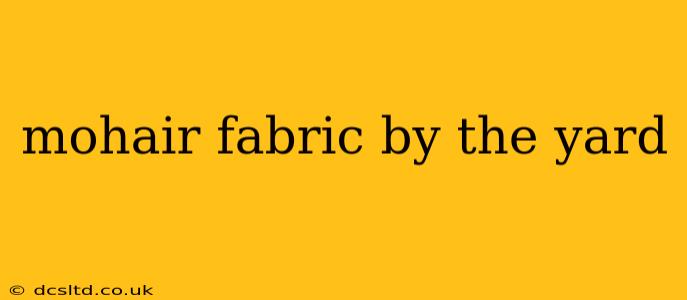Mohair, a luxurious fiber derived from the Angora goat, offers a unique blend of softness, warmth, and shimmering luster. Buying mohair fabric by the yard opens up a world of creative possibilities, from elegant apparel to cozy home décor. This guide delves into everything you need to know about this exceptional fabric, helping you choose the perfect piece for your next project.
What is Mohair Fabric?
Mohair is known for its exceptional softness and warmth, surpassing even cashmere in some respects. Its long, strong fibers create a fabric that’s incredibly durable and resistant to pilling. The unique structure of the mohair fiber gives it a natural sheen, adding a touch of elegance to any garment or textile. This inherent luster is what distinguishes mohair from other fabrics, creating a subtly shimmering effect that catches the light beautifully.
What Makes Mohair Fabric Special?
Several key characteristics set mohair apart:
- Exceptional Softness: Mohair’s softness is unmatched by many other fabrics. Its fine fibers create a luxurious feel against the skin.
- Exceptional Warmth: Despite its lightness, mohair provides exceptional warmth, making it ideal for cold-weather garments and accessories.
- Durability: The strong, resilient fibers of mohair resist pilling and wear, ensuring your projects retain their beauty for years to come.
- Luster: The natural shimmer of mohair adds a sophisticated elegance, elevating any design.
- Breathability: While warm, mohair is also breathable, preventing overheating.
What are the Different Types of Mohair Fabric?
Mohair fabric comes in various weights and blends:
- Plain Mohair: This is 100% mohair and offers the most luxurious feel and drape.
- Mohair Blends: Mohair is often blended with other fibers like wool, silk, or cotton to create fabrics with different textures and characteristics. These blends often offer increased durability or affordability. Common blends include mohair/wool, mohair/silk, and mohair/cotton. The percentage of mohair in the blend will affect the fabric's properties.
What are the Best Uses for Mohair Fabric by the Yard?
The versatility of mohair makes it suitable for a wide range of applications:
- Apparel: Coats, jackets, sweaters, scarves, and other garments benefit from mohair's warmth and luxurious feel.
- Home Décor: Throws, blankets, and upholstery fabrics made from mohair add a touch of elegance and warmth to any room.
- Accessories: Gloves, hats, and shawls made from mohair are both stylish and practical.
How Do I Care for Mohair Fabric?
Proper care is crucial to maintain the beauty and longevity of your mohair fabric. Generally, dry cleaning is recommended, especially for delicate or high-quality mohair. However, some mohair blends can be hand-washed or machine-washed on a gentle cycle using cool water and a mild detergent. Always check the care label for specific instructions.
Is Mohair Fabric Expensive?
Mohair fabric is generally considered a premium fabric, reflecting its superior quality and luxurious feel. The price varies depending on the type of mohair (plain or blended), the weight, and the supplier.
Where Can I Buy Mohair Fabric by the Yard?
You can find mohair fabric by the yard from a variety of online retailers and specialty fabric stores. Many online marketplaces offer a wide selection of colors, weights, and blends. Local fabric stores might also carry mohair, though the selection might be more limited.
What Projects are Best Suited for Mohair Fabric?
Mohair's luxurious texture and drape lend themselves to projects that showcase its elegance. Sweaters, coats, scarves, and shawls are excellent choices, highlighting the fabric's warmth and softness. For home décor, throws and blankets made from mohair add a touch of luxury and warmth to any living space.
What is the Difference Between Mohair and Cashmere?
Both mohair and cashmere are luxurious fibers, but they have key differences. Mohair is derived from Angora goats, while cashmere comes from the cashmere goat. Mohair is generally more durable and less prone to pilling than cashmere. Cashmere is known for its exceptionally soft, delicate feel, while mohair offers a slightly more resilient, lustrous texture. The choice between the two often comes down to personal preference and project requirements.
This comprehensive guide provides a solid foundation for understanding and working with mohair fabric by the yard. Remember to always check the care instructions to ensure the longevity of your beautiful, luxurious fabric.
